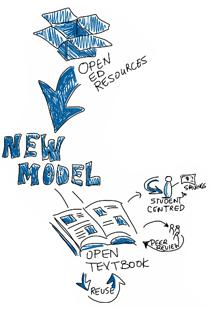Since the British Columbia government announced an Open Textbook project October 16, we have fielded many questions about it. This is Part 2 of our attempt to provide the basic information on Open Textbooks and the project itself.
 Are instructors/professors at B.C. post-secondary institutions going to be forced to use the open textbooks?
Are instructors/professors at B.C. post-secondary institutions going to be forced to use the open textbooks?
No. We understand and respect academic freedom, and there are no plans to mandate the use of the open textbooks as a result of the B.C. Open Textbook project. Many educators consider open textbooks to be consistent with faculty’s duty to students, and many have signed the Faculty Statement on Open Textbooks created by the Student Public Interest Research Group. We will be ensuring the open textbooks are of sufficiently high quality and value that faculty will be persuaded to use, re-use, re-mix and add to the repository of Open Textbooks.
How will the open textbooks be created, what’s the process?
We haven’t finalized the finer details of the process yet as we’re in the beginning stages (as of 1 November 2012). However, there are three potential paths forward that will each require faculty input.
The first would be the adoption of existing open textbooks from freely available sources. In some cases these open textbooks are available from institutions, for example Rice University’s openstaxcollege.org, or from foundation-supported collections such as Saylor.org. There are also open textbooks available from a new style of publisher that builds open textbooks and supplemental resources aimed at adoption by faculty and instructors with special options for students. Flatworldknowledge.com is one example of this sort of publishing entity (note added 5 November 2012: According to Wired Cmapus, Flatworld will no longer offer its textbooks for free, but states it is still concerned with offering cost-effective options.)
The second potential process would be adaptation of existing open textbooks to support localized instances of courses to match course outcomes in specific programs. Instructors know their students best and would want to insure that materials are customized to meet those needs. The beauty of the open resource model is the boundless opportunity presented to instructors to customize and add value to existing open resources.
The third path would involve creating a new open textbook resource where none exists, contributing to the pool of available open textbooks and becoming an active player in the development of new materials for students.
Why are we creating these free resources for everyone to use when the private college down the road could get free textbooks created with public funds?
First, we are creating these texts for the benefit of students as well as educational institutions. We expect B.C. students will use them in a public post-secondary setting, but in reality everyone in the world will be able to download the open textbooks. They will be licensed with a Creative Commons license.
On the internet, in the digital age, “sharing” content means copying and distributing – it’s limitless and free to disseminate content. Once resources are shared online, they can be shared amongst millions of people without loss of the original. We have an unprecedented capacity to educate as never before, and without sharing there is no education. Educational sharing means adapting and personalizing to adapt to learner’s needs – connecting prior knowledge and relating past experience.*
Education is much more than the textbooks and other artefacts used to educate students. The quality of instruction, the entire post-secondary experience, the learning environment all contribute to education. Post-secondary institutions do not “compete” on the content of their textbooks or courses – rather an institution provides unique educational experiences. That is what makes a student choose one institution over another (plus other factors like location, cost, etc.).
By using “our” open textbooks, private institutions will lend credibility to the public system. If they re-mix and adapt the texts, they are required under the license to share alike, also using a Creative Commons license. We say: let them in. All are welcome in the Commons.
—
See also:
Image derived from a graphic created by Giulia Forsythe and remixed/re-used under Creative Commons license.
